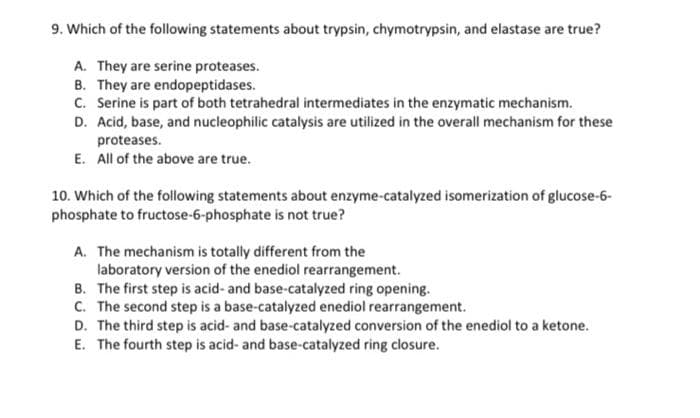9. Which of the following statements about trypsin, chymotrypsin, and elastase are true? A. They are serine proteases. B. They are endopeptidases. C. Serine is part of both tetrahedral intermediates in the enzymatic mechanism. D. Acid, base, and nucleophilic catalysis are utilized in the overall mechanism for these proteases. E. All of the above are true. 10. Which of the following statements about enzyme-catalyzed isomerization of glucose-6- phosphate to fructose-6-phosphate is not true? A. The mechanism is totally different from the laboratory version of the enediol rearrangement. B. The first step is acid- and base-catalyzed ring opening. C. The second step is a base-catalyzed enediol rearrangement. D. The third step is acid- and base-catalyzed conversion of the enediol to a ketone. E. The fourth step is acid- and base-catalyzed ring closure.
9. Which of the following statements about trypsin, chymotrypsin, and elastase are true? A. They are serine proteases. B. They are endopeptidases. C. Serine is part of both tetrahedral intermediates in the enzymatic mechanism. D. Acid, base, and nucleophilic catalysis are utilized in the overall mechanism for these proteases. E. All of the above are true. 10. Which of the following statements about enzyme-catalyzed isomerization of glucose-6- phosphate to fructose-6-phosphate is not true? A. The mechanism is totally different from the laboratory version of the enediol rearrangement. B. The first step is acid- and base-catalyzed ring opening. C. The second step is a base-catalyzed enediol rearrangement. D. The third step is acid- and base-catalyzed conversion of the enediol to a ketone. E. The fourth step is acid- and base-catalyzed ring closure.
Biology: The Dynamic Science (MindTap Course List)
4th Edition
ISBN:9781305389892
Author:Peter J. Russell, Paul E. Hertz, Beverly McMillan
Publisher:Peter J. Russell, Paul E. Hertz, Beverly McMillan
Chapter6: Energy, Enzymes, And Biological Reactions
Section: Chapter Questions
Problem 6TYK: Which of the following methods is not used by enzymes to increase the rate of reactions? a. covalent...
Related questions
Question
Please do this

Transcribed Image Text:9. Which of the following statements about trypsin, chymotrypsin, and elastase are true?
A. They are serine proteases.
B. They are endopeptidases.
C. Serine is part of both tetrahedral intermediates in the enzymatic mechanism.
D. Acid, base, and nucleophilic catalysis are utilized in the overall mechanism for these
proteases.
E. All of the above are true.
10. Which of the following statements about enzyme-catalyzed isomerization of glucose-6-
phosphate to fructose-6-phosphate is not true?
A. The mechanism is totally different from the
laboratory version of the enediol rearrangement.
B. The first step is acid- and base-catalyzed ring opening.
C. The second step is a base-catalyzed enediol rearrangement.
D. The third step is acid- and base-catalyzed conversion of the enediol to a ketone.
E. The fourth step is acid- and base-catalyzed ring closure.
Expert Solution
This question has been solved!
Explore an expertly crafted, step-by-step solution for a thorough understanding of key concepts.
This is a popular solution!
Trending now
This is a popular solution!
Step by step
Solved in 2 steps

Recommended textbooks for you

Biology: The Dynamic Science (MindTap Course List)
Biology
ISBN:
9781305389892
Author:
Peter J. Russell, Paul E. Hertz, Beverly McMillan
Publisher:
Cengage Learning

Biology: The Dynamic Science (MindTap Course List)
Biology
ISBN:
9781305389892
Author:
Peter J. Russell, Paul E. Hertz, Beverly McMillan
Publisher:
Cengage Learning